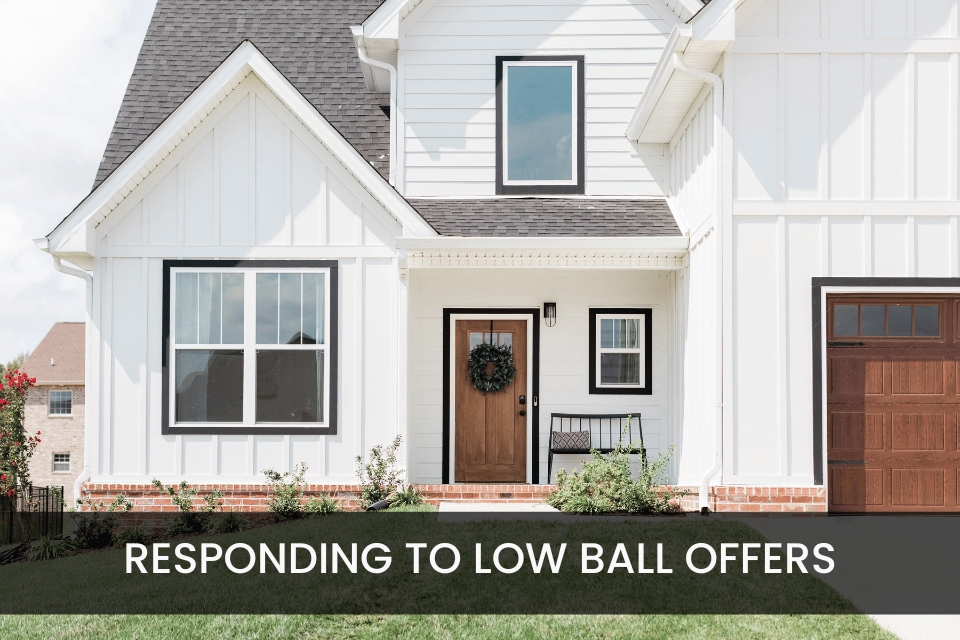How to Respond to a Lowball Offer


After all the hard work it takes to ready a home for sale, it can be so
discouraging to find the first offer you get is a lowball offer. Regardless of
the market, there are buyers who write offers 10%, 20%, even 30% below
list price. While most of these offers are just “throw-aways,” it’s still possible
to turn it into a successful sale.
Before you do anything, take a deep breath and stay calm. There are many
reasons why a buyer throws out a low offer. It could be they are getting bad
advice from a family member or nervous first-time buyers afraid of leaving
money on the table. It’s also possible that they are working with a new or
poor real estate agent. The one thing you know is that they were interested
enough in your home to write an offer, and they expect to negotiate.
The next step is to send a counteroffer. Be respectful and thank them for
the offer. If you do have room to negotiate, then offer to reduce your price
to a reasonable level. If you have priced the home well to start with, then
explain how you arrived at the list price and present any available comps.
Remember to look at the other terms offered and be flexible where you can.
For example, they may have asked for a longer escrow period, and you can
accommodate their timetable. You may also want to ask that the home
inspection is “information only” that removes the option of repairs.
A lowball offer may take the wind out of your sails, but it doesn’t mean that
there is no opportunity for moving forward. Working with your agent, send a
reasonable counter offer back to the buyer and you may find that there is
still a successful sale down the road.
Should You Repair or Replace a Roof?


One of the most important elements of any home is the roof. The roof is the
first line of defense in protecting the home from weather-related issues,
such as wind, fire, and rain. Over time, the constant abuse can take its toll,
and your roof will require some attention. But how do you know if you
should replace it or just repair it?
There are a few things to consider before making the decision.
The Age of the Roof – Most roofs come with a 10-year warranty and are
expected to last for anywhere from 20-25 years. Some tile roofs should last
even longer with some simple maintenance for the under sheathing
Extent of the Damage – Sometimes the extent of the damage is great,
such as when there has been a large storm. Other times the original roof
was not installed properly or has structural issues, causing widespread
damage
Cost – You may find when comparing the cost of the repairs to the expense
of a new root, that the new roof is simply a better value. Always get
estimates for both.
Insurance – Insurance companies view an older or deteriorated roof as a
liability. In their eyes, it’s more likely to leak, collapse, or suffer other types
of damage, which means they’re more likely to have to pay out a claim.
Because of this, some insurers require roofs to be under a certain age or in
good condition as a condition for providing coverage.
Personal Considerations – Are you planning to stay in the home for a
long time? In this case, replacement now will be more economical than
replacing later when costs have increased.
Finally, consult a few professionals. Discuss the issues for both
replacement and repair with a few trusted roofing specialists and your
insurance agent before making the final decision.
7 Ways to Save Money on Home Insurance

 Home insurance is critical for homeowners. It protects you from unexpected
Home insurance is critical for homeowners. It protects you from unexpected
damage due to fire, wind, flood, and more. Unfortunately, the cost of these
policies can be very expensive and over the past few years, some
premiums have doubled or even tripled as more natural disasters hit the
country. Fortunately, there are a few ideas on how to save money on premiums.
Here are 7 possible ideas to save money on your home insurance:
1. Bundle Policies – The easiest way to save money is to use the same
company for both auto and home. Most companies offer significant
discounts for doing all your business with them.
2. Increase Deductibles – Raising your deductible on all policies, even
just a little can save money overall. Consider how much you are able to
spend before relying on insurance and see how much you can save.
3. Home Security Systems – Most companies offer a nice discount for
home security, plus you have the added benefit of greater safety for you
and your family.
4. Good Credit – A higher credit score will likely give you a lower
premium. Be sure to ask your insurance company to review your score at
each renewal period.
5. Review Coverage – Do you have health insurance at work? Then
maybe you don’t need medical coverage through your auto policy? Review
your policies and make sure you need everything you’re paying for and
always seek the advice of your insurance agent.
6. Claim Free – Insurance is there to use, but you may not want to use it
for everything. If you have a $1000 deductible, for instance, it does not
make sense to submit a claim for damage that totals $1150. Staying
claim-free saves money. 7. Finally, shop around – At each renewal period, take the time to compare
leading companies and make changes when necessary. Switching
companies is very easy and can save you hundreds of dollars. Consult with
your insurance agent to find out if any of these ideas might work for you.
Navigating a Nightmare Final Walk-Through


The final walk-through is typically the last step in buying a home and an
exciting one. This is a last look at the home that’s about to become home to
the homebuyers. But occasionally, the buyer is shocked to see that the
home is not in the condition expected. While this can be upsetting, it does
not need to be the end of the process.
Here are 5 steps for homebuyers to take if faced with a bad final walk-through:
1. Stay Calm – First step is to stay calm. It’s important to approach the
situation without anger or passion. Not all issues are deal-breakers, and
many can be resolved easily.
2. Document Everything – Take pictures and detailed notes of any issues
encountered. This documentation will be important during conversations
with the sellers and their agent.
3. Communicate Immediately – You and your agent should immediately
reach out to the seller and their agent to discuss the challenges. You
should also reach the escrow company and lender to delay the closing until
the issues are resolved.
4. Negotiate Solutions – Be open to solutions. While time may be limited,
common solutions might include repairs, reduction of sales price, or even a
cash credit at the close.
5. Seek Legal Advice – Depending on the severity of the issues, consider
consulting an attorney. A real estate attorney can offer guidance about how
to proceed and protect your interests.
A challenging final walk-through doesn’t necessarily mean the end of the
deal, but it should be taken seriously as well. Once you transfer title, getting
compensation for a problem becomes far more difficult. Handle the issues
before the close, when all parties are motivated to find solutions.
How a Buyer’s Agent Can Be a Helpful Guide

 The real estate market is ever-evolving, and the past year has been no exception. With
The real estate market is ever-evolving, and the past year has been no exception. With
so many stories and reports, it’s understandable if you find yourself feeling uncertain
about buying a home. Questions like “Is now a good time to buy?”, “What will happen to
housing prices?”, and “How will interest rates behave?” are common and quite valid.
Deciding to buy a home involves numerous considerations, such as:
● Determining your budget.
● Deciding on your preferred location.
● Assessing if a particular home suits you, your family, and your lifestyle.
● Considering whether to make an offer.
● Evaluating the home inspection results.
● Reviewing the final loan terms and payments.
These are just a few aspects of the home-buying process, and it’s a journey you don’t
have to embark on alone. Engaging a buyer’s agent can be a beneficial step. A buyer’s
agent aims to guide you through the buying process, addressing your questions,
negotiating on your behalf, and discussing various options and decisions with you.
While the current market might seem daunting, having a professional buyer’s agent by
your side can provide support and insight, potentially making the process more
manageable and less overwhelming.
Are The Bidding Wars Over?

Let’s face it, it’s fun to have a home listing during a seller’s market. When
inventory is tight, even less-than-perfect homes invite the frantic bidding
wars seen over the past few years. But as the economy slows down and
interest rates increase, sellers are wondering if the bidding wars are over,
and what that means for them.
First of all, bidding wars have occurred in every kind of real estate market.
Well-positioned homes have always garnered attention and offers. What’s
different in a seller’s market is that buyers are so desperate to find a home,
that multiple offers seem to be normal on every listing. As the pace slows
down, sellers need to adjust their expectations and avoid costly mistakes.
Seller Mistakes to Avoid in a “Normal” Market
· Bad Curb Appeal – Curb Appeal is once again important to making a
good impression.
· Delayed Response – Don’t wait to respond to a buyer’s offer
because you hope to have a bidding war.
· Unreasonable Demands – Buyers have choices now, be reasonable
with the counter and contingencies.
· Highest Offer – Don’t assume that the highest offer is the best offer.
· Priced too Low or too High – Price the home correctly. Don’t play
games with the price.
Finally, be patient. In a typical market, an average home is on the market
30-45 days. This is a change from the past few years, but a healthy real
estate market benefits all parties
6 Features of a Kitchen Remodel That Are a Waste of Money

Kitchen remodels are always popular. The pandemic has increased home
improvement projects even more as people embrace the idea of staying
home more. While it’s easy to find inspiration for these kitchen remodels,
there are great ways to save money and still create a beautiful, welcoming
space.
6 Kitchen Remodel Features That Are a Waste of Money
1. Expensive Backsplashes – Backsplashes can make a huge visual
impact, but more expensive isn’t necessarily better. There are many
cost-effective materials that mimic more expensive quartz, marble, and
glass.
2. Designer Appliances – Designer labels look great on shoes and
purses but look for style and function for new appliances and forget the
designer brands that can cost twice as much for the same look.
3. Trendy Hardware – Hardware is one of the least expensive ways to
update a kitchen, but there is still a cost. Balance personal style with price
and avoid fad fixtures that will need to be replaced soon.
4. High-Tech Gadgets – Tech is fun, but will you really use your
refrigerator to build a shopping list or turn on your oven from the beach?
Most likely, tech gadgets in the kitchen will go to waste.
5. Moving Electrical/Plumbing – When possible, work within the
current layout of electrical and plumbing access. Relocating these sources
is expensive and difficult.
6. Open Shelving – Displaying beautiful plates and glassware may be
appealing but consider the upkeep to maintain this look. You may end up
adding closed cabinets anyway for more money after the remodel.
A kitchen remodel is exciting but expensive and time consuming.
Fortunately, there are ways to lower the cost and still have the fresh,
beautiful kitchen you’ll want to spend time in.
6 DIY Home Projects That Could Kill Your Home Value

Weekend TV lineups are filled with Do-It-Yourself home improvement
programs. One home inspector used to call the results “six-pack projects.”
While not all DIY projects end in disaster, some projects can harm home
sales because buyers see these “improvements” as changes they will need
to make once they buy the house. If you are planning to sell soon, it’s
important to realize that potential buyers may not be as impressed with
your handiwork as you are.
6 DIY Projects that Can Kill Your Home Value
1. Garage Conversion – Homebuyers love extra square footage, but
they don’t want it in the garage. Most buyers will plan to “unconvert” a
game room back to space for their cars or storage.
2. New Doors – New doors can add beauty to a room, but if they are
not mounted properly, they land on a new buyer’s list of things to fix.
3. Uneven Hardware – If you are trying to update cabinets with new
hardware, make sure they are level and line up evenly.
4. Crown Molding – Seems like an easy upgrade but adding elegant
crown molding is very difficult and ends up looking sloppy.
5. Painting to Hide Problems – Cracks, gaps, and surface defects only
look worse when covered with fresh paint.
6. Kitchen Cabinets – Old, worn cabinets should be replaced if
possible. As with the walls, a fresh coat of paint only accentuates the dated
look.
Every seller knows they need to freshen their home and add curb appeal to
list their home. Before launching into a frenzied weekend of DIY projects,
speak to a professional agent or stager and make sure you don’t make
things worse in the eyes of your potential buyers.
Is My House Up to Code?

Building codes change over time and for people who have owned their
homes for a long time, they may not know if their home is out of code and if
so, does it matter.
Building codes and violations from jurisdiction to jurisdiction and focus on
issues that can affect the safety of the dwelling and its occupants. A home
that’s “up to code” may answer the questions:
· Does the home have fire escapes and exits?
· Are plumbing lines intact and functional?
· Are construction materials in good condition and free from asbestos
and other hazardous chemicals?
· Is the home well-lit and free from tripping hazards?
· Is the HVAC system working efficiently?
Avoid Code Violations
There are things to look for in both an existing house and a potential home.
· Check for any permits on the home and always ensure any work
done on the home includes permits.
· Test for hazardous materials such as asbestos or lead. These
materials are common in older homes. If found, these need to be removed
by professionals to avoid health issues from contamination.
· Poor bathroom ventilation is a big code violation. The humidity can
lead to rot and mold which is expensive to remove and dangerous to the
occupants’ health.
· Shoddy electrical work is also common in older homes. Lack of
grounded wires, spliced wires, and DIY repairs duct-taped together can be
very dangerous.
Understanding code violations can help the homeowner to avoid issues. All
this information is readily available through local jurisdictions and home
inspectors can provide more explanations to help mitigate any problems.
Should I Move For My Job?

The question of moving for a new job is not uncommon. In the past few
years, more and more companies are moving their entire operations out of
high-tax states to those more business-friendly. Possible work-from-home
options further complicate the decision to move with your company. So,
should you move when your company does?
Things to Consider Before You Move for Your Company
· Career Growth – One of the biggest reasons to stay with your job
through a move is career growth and advancement. Speak with your
manager or HR professional about what kind of career path is available
before you decide.
· Better Location – Companies moving out-of-state often move to a more
desirable location. If the new area appeals to you, then using a corporate
relocation package can be a cost-effective way to move to a better location.
· Personal Relationships – Moving away from family and friends may be
too high a price to pay to stay with your company. Aging parents or the
school your children enjoy may encourage you to stay put.
· Remote Working Option – If you do not want to move, ask if a
work-from-home situation is available. If so, understand the impact it may
have on your career.
One big advantage a move like this has is you already know the company,
the employees, and the corporate culture. Consider all the options available
and you’ll be able to make the best decision for you and your family.


 Facebook
Facebook
 X
X
 Pinterest
Pinterest
 Copy Link
Copy Link

